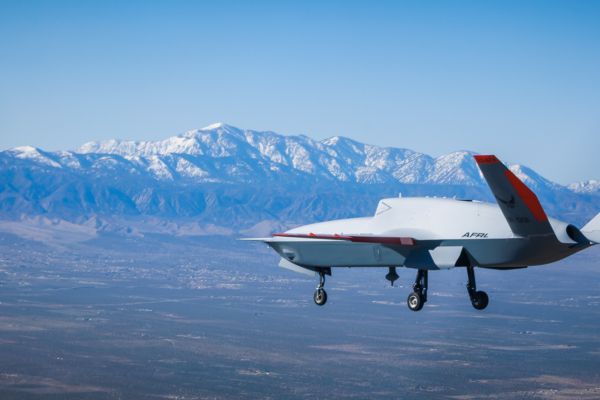The U.S. military recently released the first test flight video of the “Collaborative Combat Aircraft” (CCA), commonly known as the “loyal wingman,” XQ-67A unmanned aircraft, demonstrating the progress of the XQ-67A project. This drone will serve as the loyal wingman for the U.S. military’s sixth-generation fighter jets, enhancing the capabilities of the aircraft and marking a significant leap in the future combat aircraft of the U.S. Air Force.
The XQ-67A unmanned aircraft system (UAS) was developed by General Atomics and conducted its maiden flight at Gray Butte Field Airport in Palmdale, California. The U.S. Air Force captured a video of this first flight that lasted over a minute.
On June 26, the U.S. Air Force announced that the Air Force Research Laboratory (AFRL) successfully test-flew the second-generation Autonomous Collaborative Platform (ACP) XQ-67A demonstrator on February 28, 2024, as part of the Off-Board Sensing Station (OBSS) program.
Dubbed as an “off-board sensing station,” the XQ-67A is a new type of unmanned aircraft following the first-generation autonomous collaborative platform XQ-58A Valkyrie, and it is the first aircraft of the second-generation Autonomous Collaborative Platform project.
The Air Force noted that the XQ-67A is the first of its kind built based on the “genus/species” concept. The successful maiden flight of the XQ-67A validated the effectiveness of the “genus/species” approach, enabling faster replication and cost-effective production of aircraft.
This concept originated from the U.S. military’s “Low-Cost Attritable Aircraft Platform Sharing” (LCAAPS) program proposed in the 2010s, focusing on constructing multiple aircraft variants from a common core airframe.
The new approach aims to provide cost-effective advanced combat capabilities to warfighters swiftly in response to challenges posed by major power competition, said the Air Force.
The new video showcasing the collaborative combat aircraft signifies a historic moment in the Air Force’s plan for the future, released by the Air Force Research Laboratory. The video depicts the XQ-67A taking off at dawn, flying a short distance, and then landing back at an Air Force base.
Although the XQ-67A is a remotely controlled aircraft, it possesses autonomous flying capabilities. Despite General Atomics announcing three additional test flights on April 24, the Air Force only recently released the first test flight video.
The aircraft is designed with a stealthy configuration, landing gear, and a nose-up attitude. The entire aircraft features a shoulder-mounted intake, small swept-back wings, and a V-tail aerodynamic layout.
Currently, the U.S. Air Force and Navy are developing CCA unmanned aircraft as part of the Next-Generation Air Dominance (NGAD) program.
NGAD comprises two sixth-generation fighter development projects: the Air Force is working on a manned air dominance fighter system to replace the F-22 Raptor, while the Navy is developing a multi-role carrier-based fighter known as F/A-XX to succeed the F/A-18 Super Hornet.
The LCAAPS project is considered a significant step towards developing collaborative combat unmanned aircraft (CCA) in coordination with the U.S. sixth-generation manned fighter program. The CCA holds great importance for the development of next-generation tactical aircraft for the U.S. Air and Navy forces.
With the emergence of two ongoing local wars worldwide, in Ukraine and Gaza, drones have played crucial roles on the battlefield. Considering China’s rapid drone development, the XQ-67A is poised to tackle future warfare against such adversaries with cutting-edge technology.
General Atomics has stated, “The CCA program aims to be a force multiplier, developing a low-cost, modular unmanned aircraft equipped with advanced sensors or weapons to operate collaboratively with next-generation manned fighter aircraft.”
Senior U.S. military expert Kris Osborn mentioned on the “Warrior Maven” website last year, “For instance, a loyal wingman drone could provide ISR cover over an area, test enemy air defenses, disrupt enemy communications, and even conduct offensive strikes under human command, while the manned fighter executes command and control missions at a safer standoff distance.”
In November last year, Air Force Secretary Frank Kendall reiterated the Air Force’s plan to procure at least 1000 CCAs, with expectations for this number to increase significantly in the future.
Even though CCA or “loyal wingman” drones are envisioned as a system developed around sixth-generation fighters, these drones are not solely for the sixth-generation fighters. Airbus is developing “loyal wingman” drones to complement the German Air Force’s existing Eurofighter fleet, indicating these drones can potentially pair with existing fourth-and-a-half and fifth-generation fighters.
At the Berlin International Aerospace Exhibition (ILA) in early June, Airbus unveiled a full-scale concept model of a drone called “Wingman.” The model showcased all the anticipated functions of such drones, including stealth capabilities, integration of various weapons, advanced sensors, connectivity, and collaborative solutions. In Airbus’s vision, the “Wingman” will serve as an unmanned escort for fighter jets, controlled by pilots of current active fighter jets like the Eurofighter, to execute high-risk tasks for manned aircraft.

